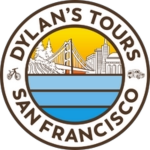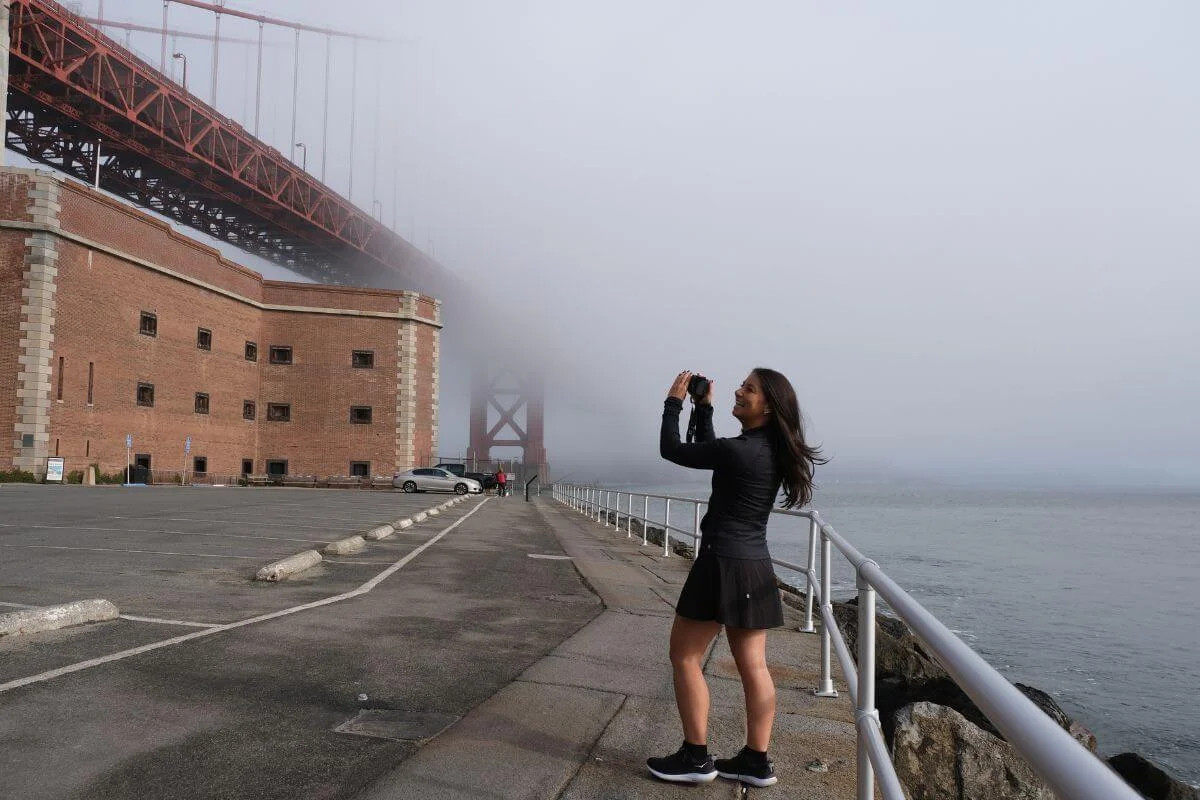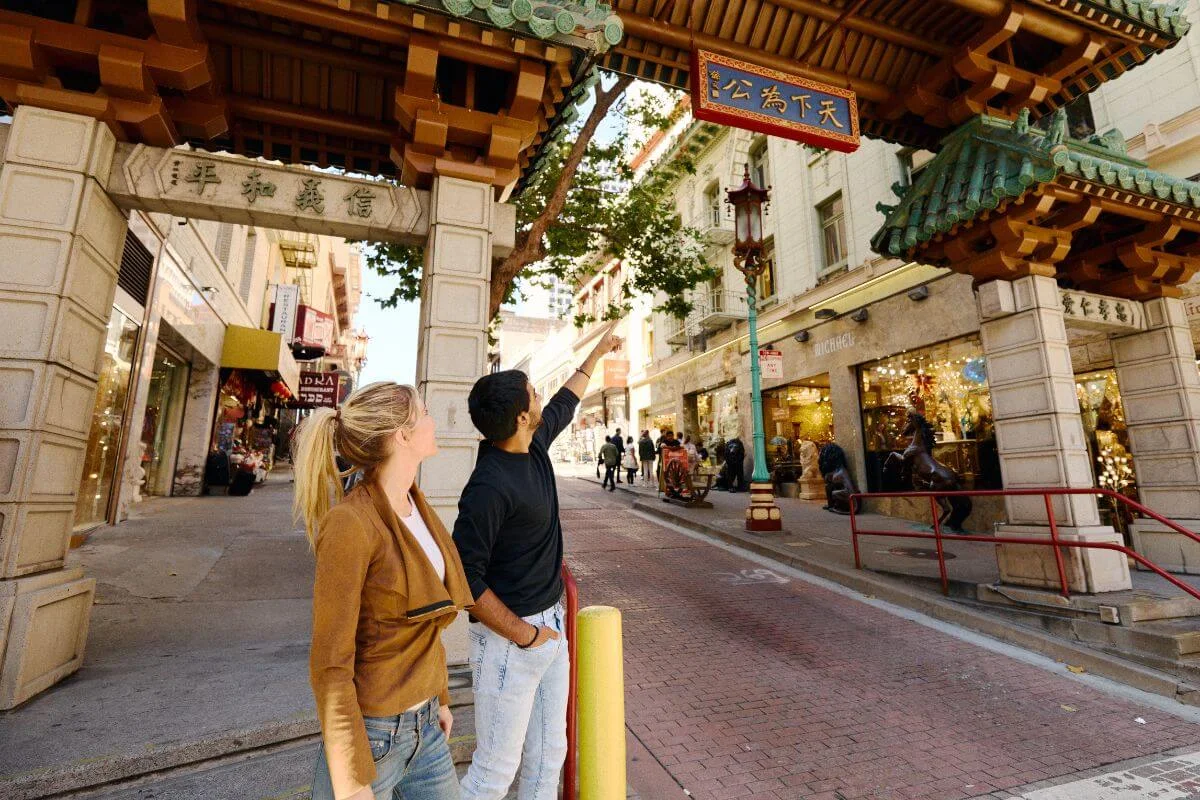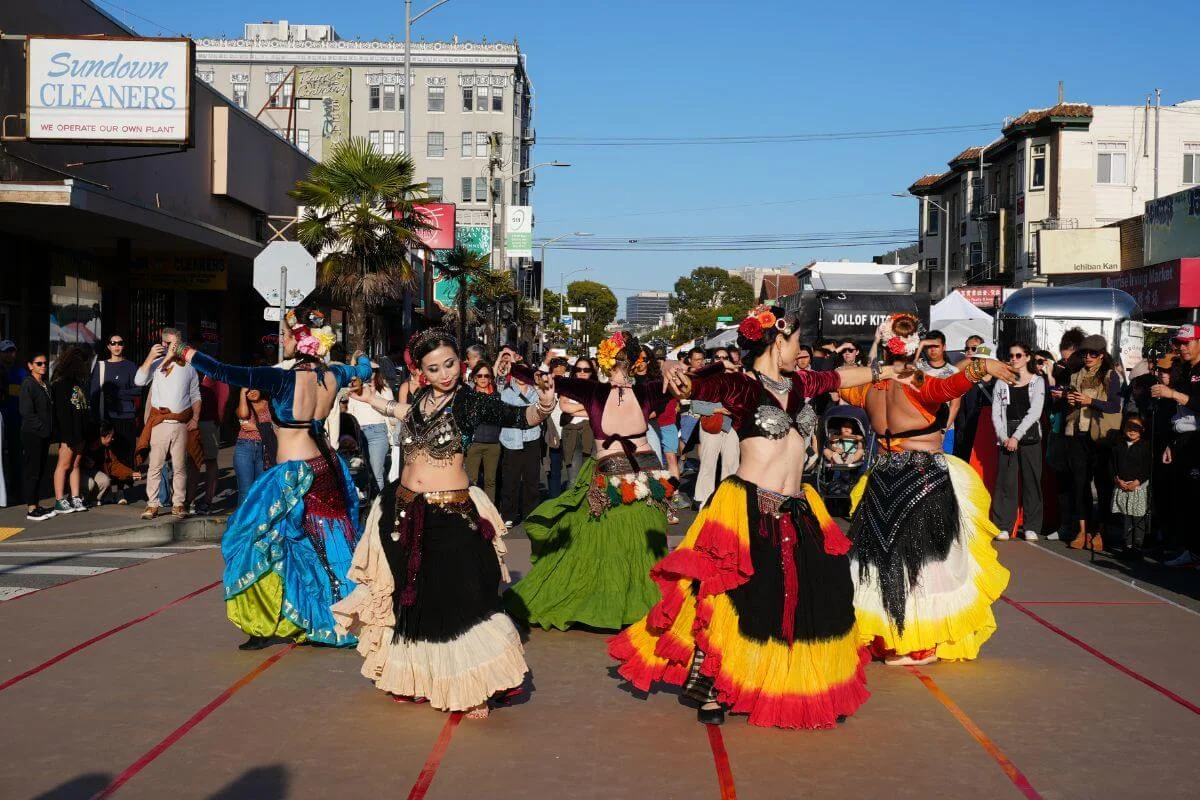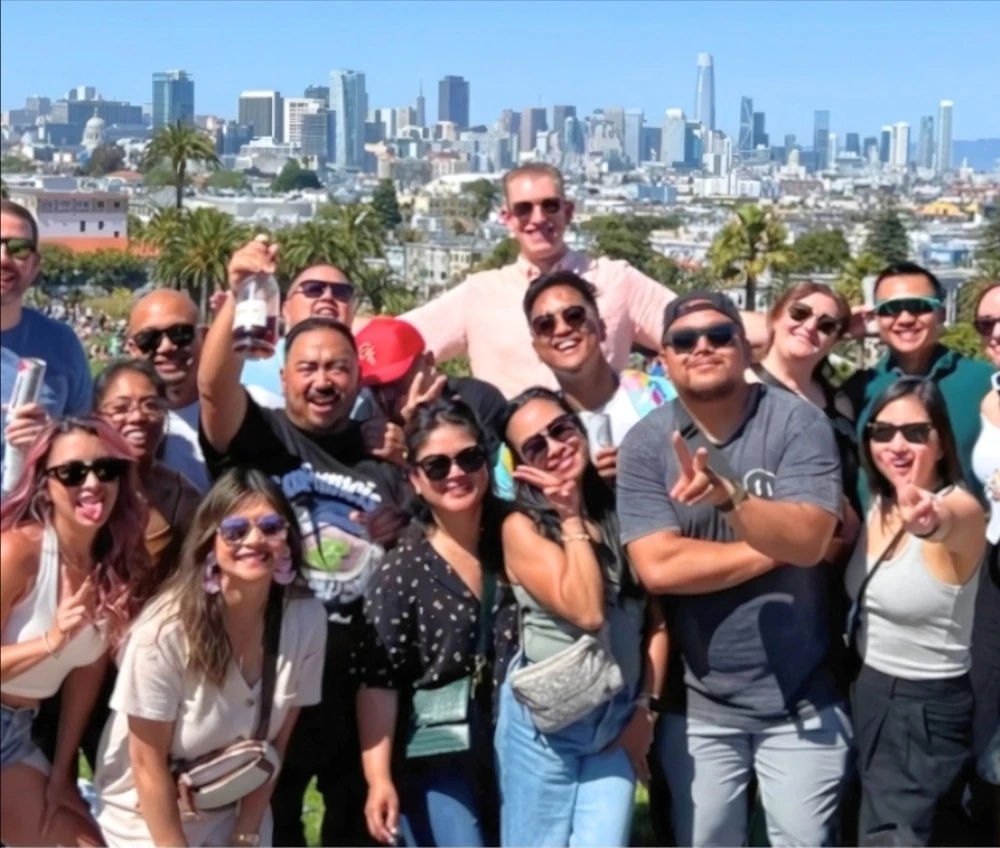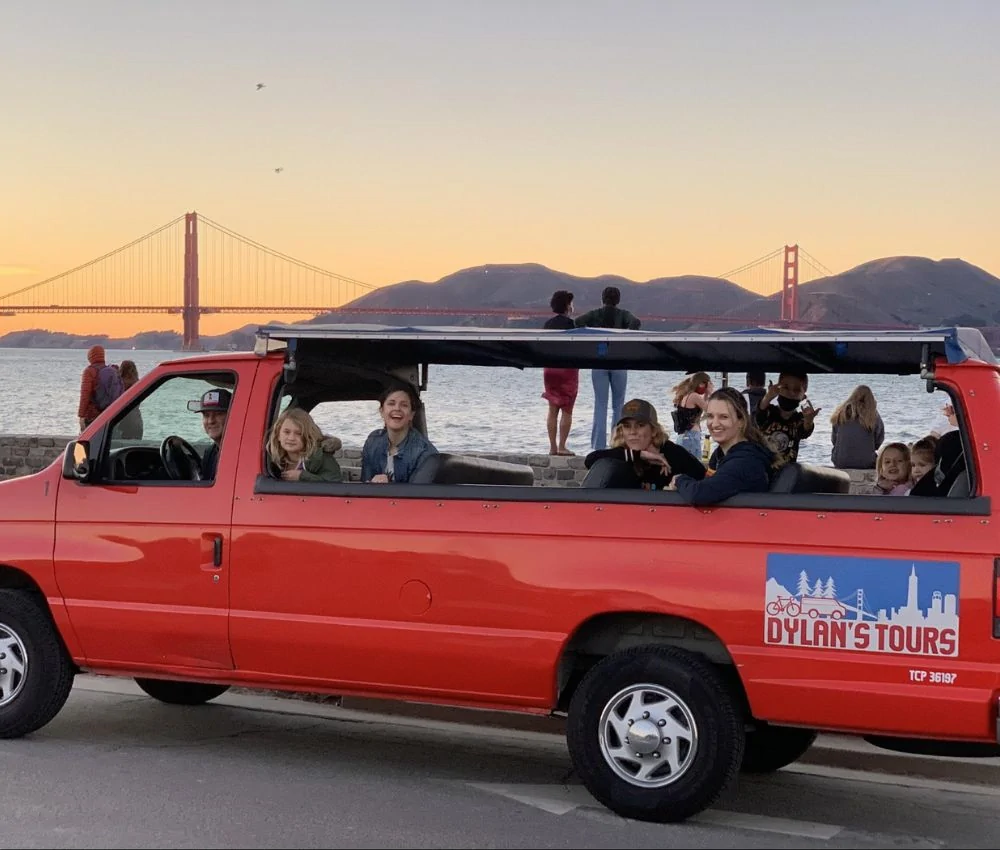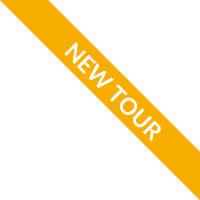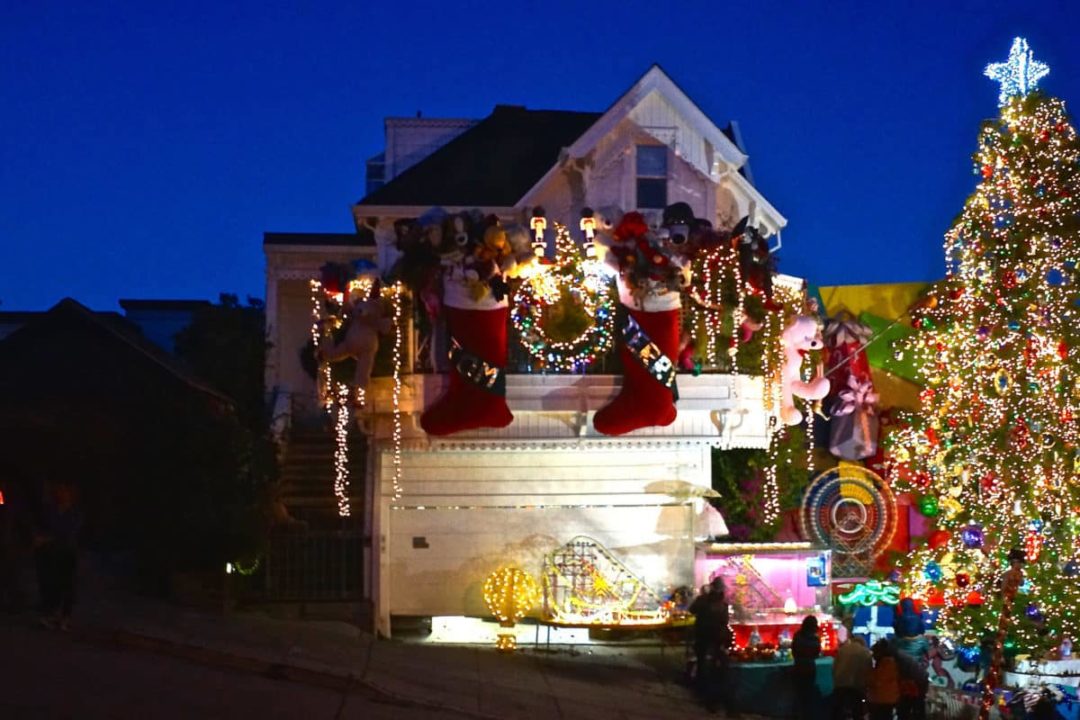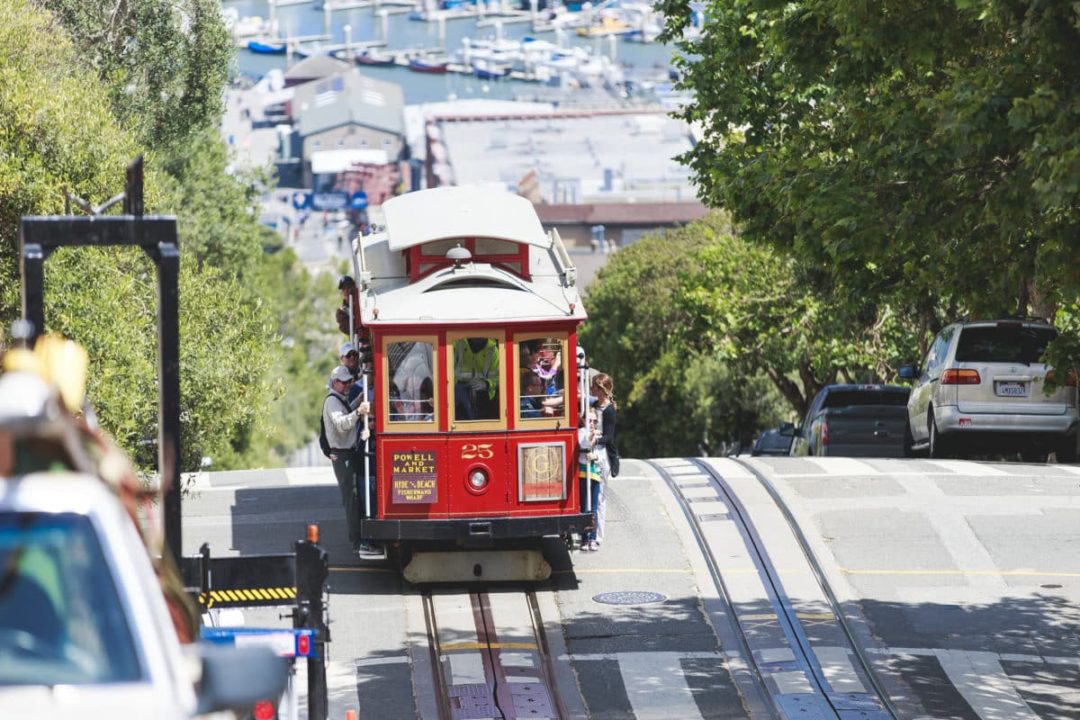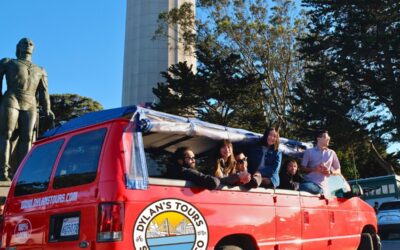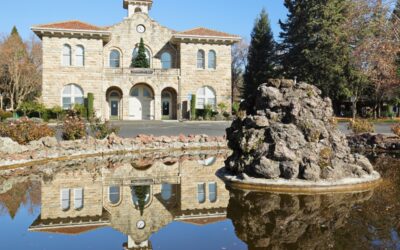This guide reveals 27 of the best free things to do in San Francisco. You’ll discover famous attractions alongside local favorites that most visitors miss. Whether you’re planning your first visit to San Francisco or you’ve lived in the Bay Area for years, these free activities reveal the real character of the city—and they’re a ton of fun!
Of course, free fun is just the beginning…
When you’re ready to get even more out of your San Francisco vacation, our locally led tours bring the city to life. You’ll see all the iconic landmarks and neighborhoods, uncover hidden stories, and experience the real San Francisco beyond the guidebooks (without ever stressing about logistics.)
Discover why more than 4,000 happy travelers have given Dylan’s Tours a five-star rating on TripAdvisor.
Find your perfect San Francisco Tour today.
Iconic Landmarks & Bucket-List Views
1. Walk or Bike Across the Golden Gate Bridge
The Golden Gate Bridge stands as one of San Francisco’s most recognized structures. Walking across it gives you an entirely different perspective than viewing it from afar.
You can access the bridge from multiple points. The most popular starting location is the Bridge Pavilion on the San Francisco side, where you’ll find parking and visitor information. The walk spans 1.7 miles each way, taking about 30-40 minutes at a comfortable pace.
Mornings often bring fog that wraps around the towers, creating an ethereal atmosphere. Late afternoons offer clearer views and warm golden light. Dress in layers regardless of when you visit. The bridge sits in one of the windiest spots in the city, and temperatures can drop 15-20 degrees compared to downtown.
Want to immerse yourself in the best of San Francisco? From exploring the Palace of Fine Arts to getting that perfect photo of the Golden Gate Bridge, Dylan’s Famous Tour shows you the best of SF while sharing the rich history and stories behind these landmarks.
Book Dylan’s Famous Tour and see the Golden Gate Bridge!
2. Take in the Sunset at Baker Beach and Ocean Beach
Baker Beach gives you postcard views of San Francisco with sand between your toes. This mile-long stretch sits on the northwest edge of the city, tucked beneath the Presidio’s coastal bluffs.
The north end of Baker Beach offers the most dramatic bridge views. You can watch cargo ships pass beneath the span while waves crash against rocky outcrops. The beach faces west, making it ideal for sunset photography when the bridge silhouette stands against colorful skies.
Ocean Beach stretches for three miles along San Francisco’s western edge. This is where locals come to watch the Pacific, walk their dogs, and escape the urban density just blocks away. The beach faces directly west, making it one of the best free spots to catch the sunset at Ocean Beach, creating spectacular evening displays from April through October.
3. Experience Panoramic Views from Twin Peaks
Twin Peaks sits 922 feet above sea level, making it the second-highest point in San Francisco. The summit offers 360-degree views of San Francisco that span from the Pacific Ocean to the East Bay hills, including Oakland in the distance.
You can drive directly to the viewing area or hike up from various neighborhood access points. The summit has a paved parking area and viewing platform, though spaces fill quickly on clear days and weekends.
From the top, you’ll be able to see the entire city layout, and the grid system of downtown streets becomes visible. You can even trace the path of Market Street from the Ferry Building to the Castro. On clear days, visibility extends to Mount Diablo in the East Bay and Mount Tamalpais in Marin County.
4. Visit the Painted Ladies and Alamo Square Park
No visit to San Francisco is complete without seeing the Painted Ladies!
Seven Victorian houses stand in a perfect row along Alamo Square’s eastern edge. These “Painted Ladies” appear in countless photographs, postcards, and television shows, making them one of San Francisco’s most recognizable images.
Alamo Square Park itself spreads across four city blocks on a hilltop in the Western Addition neighborhood. The sloping lawn provides the perfect vantage point for photographing the houses. You’ll share the space with locals having picnics, playing with their dogs, and enjoying the afternoon sun.
The park offers views of San Francisco beyond just the Painted Ladies. From the hill’s crest, you can see the Golden Gate Bridge, the Transamerica Pyramid, and Salesforce Tower. Early morning provides the best light for photography, and you’ll avoid the crowds that gather during midday and late afternoon.
5. Walk Down Lombard Street
Lombard Street’s eight hairpin turns wind down a single city block on Russian Hill. The street drops at a 27-degree angle, making it too steep for regular traffic, so designers created the serpentine path in 1922. Lush gardens fill the spaces between the turns, maintained by residents who live along the famous block. Hydrangeas bloom in summer, adding splashes of blue and pink against the brick roadway.
The view from the top looks down over San Francisco Bay and out toward Coit Tower. The descent takes just a few minutes, but you’ll want to pause at several points to take photos and watch cars navigate the tight turns below.
While not free, for the best way to experience Lombard Street, don’t miss The Lombard Leap! The Lombard Leap offers an intimate journey through San Francisco’s iconic spots, including a drive down the world-famous Lombard Street.
Available as a $10 add-on when you book Dylan’s Famous Tour with Muir Woods — it’s the perfect way to complete your city experience.
6. Watch the Bay Bridge Lights
The Bay Bridge lights up each night with 25,000 LED lights creating patterns across the western span. Artist Leo Villareal designed the installation, which stretches 1.8 miles along the bridge’s cables.
The lights create abstract patterns that never repeat. The display runs from dusk until 2 a.m. every night, visible from multiple locations around the San Francisco Bay Area.
The Embarcadero provides some of the best viewing locations. Walk along the waterfront between the Ferry Building and Pier 39 to see the installation from different angles. The lights reflect off the bay water, doubling the visual impact on calm nights.
The installation was originally temporary but became so beloved that it was made permanent through community fundraising and support.
Parks & Outdoor Escapes
7. Hike the Golden Gate National Recreation Area and Presidio
The Golden Gate National Recreation Area encompasses 82,000 acres of protected land across San Francisco, Marin, and San Mateo counties. Within city limits, the Presidio offers the most accessible hiking with trails that range from easy walks to challenging climbs.
The Batteries to Bluffs Trail descends from the Presidio’s coastal overlooks down to Baker Beach. This steep path drops through cypress groves and native plants, offering increasingly dramatic views of the Golden Gate Bridge as you descend. The round trip covers about 1.5 miles with significant elevation change.
The Ecology Trail loops through the Presidio’s forest areas, showcasing the restoration work that has transformed the former military base into thriving natural habitat. You’ll walk beneath eucalyptus and cypress trees while learning about native plant restoration through interpretive signs along the route.
Land’s End Coastal Trail runs from the Sutro Baths ruins to Eagle’s Point, following the cliffs above the Pacific. This 3.4-mile out-and-back trail provides constant ocean views and glimpses of the Golden Gate Bridge. The path passes through cypress groves and offers access to Mile Rock Beach for those willing to scramble down steep trails.
Most Presidio trails connect, allowing you to create longer routes by combining multiple paths. The area’s hills mean almost every hike includes elevation gain, but the payoff comes in Golden Gate Bridge views that span from the Pacific to the bay.
8.Spend An Afternoon at Mission Dolores Park
Mission Dolores Park occupies two city blocks on a hillside in the Mission District. The sloping lawn provides natural amphitheater seating with downtown skyline views that draw crowds on sunny days.
The park attracts a diverse mix of San Franciscans. You’ll see families with young children on the playground, groups playing pickup soccer, people practicing yoga, and friends gathering for afternoon picnics. The social atmosphere makes it feel more like a community gathering space than a typical urban park.
Weekend afternoons transform the park into San Francisco’s outdoor social scene. Food vendors set up along the park’s edges. A mariachi band might perform in one section while a drum circle gathers in another. The energy peaks between 2 p.m. and 5 p.m. when the fog typically stays west of Twin Peaks.
9. Explore the Gardens and Meadows of Golden Gate Park
Golden Gate Park stretches from the Haight-Ashbury neighborhood to Ocean Beach, covering 1,017 acres. The park was built on sand dunes in the 1870s, transforming what seemed like unusable land into San Francisco’s premier green space.
The park contains multiple gardens, lakes, meadows, and cultural institutions. You can spend hours wandering without covering half its area. Free attractions include the Music Concourse, Stow Lake, the Dutch Windmill, and the Buffalo Paddock.
Free concerts happen regularly at the Music Concourse during summer months. The San Francisco Symphony and other groups perform in the outdoor bandshell, drawing crowds who spread blankets on the lawn.
10. Visit the Japanese Tea Garden on Free Days
The Japanese Tea Garden opened in 1894 as part of the World’s Fair held in Golden Gate Park. It’s the oldest public Japanese garden in the United States, spanning five acres with traditional design elements.
Admission is free before 10 a.m. on Monday, Wednesday, and Friday. Arriving at opening allows you to experience the garden before crowds arrive and gives you the best light for photographs.
The garden features a traditional tea house, arched drum bridges, stone lanterns, and carefully pruned trees that create the aesthetic of a Japanese landscape in miniature. Koi swim in ponds beneath the bridges. Stone paths wind between plantings that change with seasons.
11. Discover Presidio Tunnel Tops and Crissy Field
The Presidio Tunnel Tops opened in 2022, creating a 14-acre park above the highway tunnels that run through the former military base. The park includes meadows, walking paths, play areas, and outdoor seating with unobstructed views of the Golden Gate Bridge.
The design connects the Presidio’s Main Post to Crissy Field, making it easy to walk between the two areas without crossing busy streets. You’ll find food vendors, picnic areas, and open lawns perfect for relaxing while taking in bridge views.
Crissy Field stretches along the bay shoreline, offering a two-mile waterfront path popular with walkers, runners, and cyclists. The path runs from Fort Point at the base of the Golden Gate Bridge to the Marina District, providing constantly changing views of the bridge, bay, and San Francisco city skyline.
Climb San Francisco’s Hidden Staircases
San Francisco’s steep hills created the need for public staircases that connect streets at different elevations. Many of these stairways have become destinations themselves, offering unique perspectives on the city’s neighborhoods.
The Filbert Steps descend from Telegraph Hill toward the Embarcadero, dropping through lush gardens that residents maintain along the route. The stairs pass through three different street levels, with views opening up as you descend. Wild parrots nest in the area, and you’ll likely hear their distinctive calls as you walk.
The 16th Avenue Tiled Steps in the Outer Sunset feature 163 steps covered in a mosaic created by local artists and residents. The design depicts the sea-to-sky journey, with ocean creatures at the bottom transitioning to celestial themes at the top. Climb to the summit for views across the city to Twin Peaks.
The Lyon Street Steps in Pacific Heights offer a more formal experience, with two parallel staircases flanking a manicured garden. The climb covers four city blocks, rewarding you with bay views and a look into one of San Francisco’s most expensive neighborhoods.
12. Walk the Lands End Coastal Trail
The Lands End Trail follows the cliffs above the Pacific Ocean from the Legion of Honor museum to Eagle’s Point. This 1.7-mile path provides some of San Francisco’s most dramatic coastal scenery without leaving the city.
The trail passes the ruins of the Sutro Baths, a massive public swimming complex that burned down in 1966. The concrete foundations remain visible in the rocks below, filling with tide pools at low water. You can scramble down for a closer look, though the path is steep and can be slippery.
Views of the Golden Gate Bridge appear throughout the hike, framed by cypress trees and coastal scrub. Mile Rock Beach sits below the trail’s midpoint, accessible via a steep side path for those wanting to get closer to the water.
13. Tour Fort Point Under the Golden Gate Bridge
Fort Point sits directly beneath the south tower of the Golden Gate Bridge. This brick fortress was built between 1853 and 1861 to protect San Francisco Bay from naval attack, though it never fired its cannons in combat.
The National Park Service maintains the fort and admission is free daily. You can explore three tiers of gunrooms, barracks, and defensive positions while learning about Civil War-era military architecture. The arched brick casemates create dramatic photographs, especially when sunlight streams through the gunports.
Culture, History & Local Vibes
14. Watch the Sea Lions at Pier 39
Sea lions started hauling out on the floating docks at Pier 39 in 1990, shortly after the Loma Prieta earthquake. They’ve stayed ever since, making the spot one of San Francisco’s most popular free attractions.
The number of sea lions varies by season. Winter months can bring 900 individuals crowded onto the docks, barking and jostling for position. Summer typically sees fewer animals as many migrate north following food sources. Even when numbers are low, you’ll usually find at least a few dozen sea lions lounging on the platforms.
The best viewing happens during feeding time when sea lions become more active. They’re most energetic in the morning and late afternoon, though you can spot them throughout the day.
15. Learn Cable Car History at the Cable Car Museum
The Cable Car Museum sits in the building that houses the powerhouse and car barn for San Francisco’s cable car system. You can watch the massive sheaves that pull the cables through their continuous loops while learning how the system works.
The museum displays historic cable car models, including the first car from 1873 and ornate cars from the system’s peak era. Photographs and artifacts document the role cable cars played in San Francisco’s development and their near-demolition in the 1940s and 1950s.
Admission is always free, though donations are encouraged to support the museum and cable car preservation. The museum shop sells cable car memorabilia, with proceeds supporting operations.
Discover all the best museums in San Francisco in this ultimate guide!
16. Explore the Streets and Alleys of Chinatown
San Francisco’s Chinatown is the oldest in North America and the largest Chinese enclave outside Asia. Walking the neighborhood costs nothing and reveals layers of culture, history, and daily life that remain distinct from surrounding areas.
Grant Avenue serves as the main tourist corridor, with shops selling everything from traditional herbs to souvenirs. The architecture features colorful facades, curved rooflines, and ornate details that were added in the 1920s to attract visitors after the 1906 earthquake.
Step off Grant Avenue to find the neighborhood’s authentic character. Stockton Street runs parallel one block west, serving as the commercial heart where residents shop for groceries, housewares, and traditional goods. The sidewalks fill with crates of fresh produce, live fish in tanks, and shoppers speaking Cantonese.
The Chinese New Year Parade in February brings crowds that fill the neighborhood’s streets. The celebration includes dragon dances, firecrackers, and floats that wind through Chinatown and downtown. Smaller festivals and events happen throughout the year, many visible from the public streets.
17. Admire the Palace of Fine Arts
The Palace of Fine Arts is a classic stop on Dylan’s Famous Tour for good reason!
This landmark stands as the sole surviving structure from the 1915 Panama-Pacific Exposition. The massive rotunda and colonnaded gallery were designed in classical Roman style, creating a dramatic setting that seems transported from ancient Europe.
The building sits beside a small lagoon where ducks and swans glide across the water. The reflection of the rotunda columns in the still water creates one of San Francisco’s most photographed scenes. The grounds stay open from sunrise to sunset, providing access without charge.
Walking beneath the rotunda and through the colonnade reveals architectural details that reward close inspection. The ornate capitals, decorative friezes, and massive scale demonstrate the ambition of early 20th-century exposition architecture.
The surrounding Palace Green provides open lawn space popular with picnickers, wedding photographers, and families. On weekends, you’ll often see photo shoots in progress, taking advantage of the dramatic backdrop.
The nearby Exploratorium museum now occupies a separate modern building on the bayfront. Museum admission requires a ticket, but the Palace of Fine Arts grounds remain free to explore and worth a visit for any trip to San Francisco.
18. Discover Mission District Murals
The Mission District contains one of the largest concentrations of public murals in the United States. Hundreds of painted walls transform alleys, building facades, and garage doors into an outdoor gallery that reflects the neighborhood’s Latino heritage and social activism.
Balmy Alley between 24th and 25th Streets features more than 30 murals covering nearly every available surface. The artworks address themes ranging from Central American politics to environmental justice to community history. Many date to the 1970s and 1980s, though new murals continue to be added.
Clarion Alley near Valencia Street presents a different aesthetic. The art here changes more frequently, with new pieces appearing monthly. The alley serves as a canvas for contemporary street artists, creating a constantly evolving exhibition where you can enjoy art without any admission cost.
The Women’s Building at 18th and Lapidge Streets features “MaestraPeace,” a massive mural covering the entire facade. The artwork celebrates women’s roles in culture and society through images drawn from multiple traditions. The building remains one of the Mission’s most recognizable landmarks.
Individual murals appear throughout the district, often requiring no more than walking down residential streets with your eyes open. The concentration is highest between 16th and 25th Streets, from Mission Street to Potrero Avenue.
19. Browse the Ferry Building Marketplace
The Ferry Building anchors the Embarcadero waterfront with its 245-foot clock tower visible from around the bay. The 1898 structure served as the city’s transportation hub before bridges reduced ferry traffic, then underwent restoration in the early 2000s to become a food marketplace.
Walking through the Ferry Building Marketplace costs nothing and exposes you to artisan food vendors, specialty shops, and the energy of a working market. You’ll pass cheese counters, bakeries, butchers, and produce stands representing some of the Bay Area’s best food producers.
The Saturday farmers market sets up both inside and outside the building, drawing crowds who come for fresh produce, prepared foods, and the social atmosphere. The Tuesday and Thursday markets are smaller but less crowded.
20. Experience the California Academy of Sciences on Free Days
The California Academy of Sciences combines an aquarium, planetarium, natural history museum, and rainforest dome under a living roof in Golden Gate Park. Regular admission requires tickets, but the museum offers free admission on select days throughout the year.
Free days typically occur on the third Tuesday of every month, though the schedule changes, and you should look for free admission opportunities on the museum’s website. Community organizations sometimes sponsor additional free days targeted to specific groups.
The museum’s highlights include a four-story rainforest enclosed in a glass sphere, a living roof planted with native California species, and the Steinhart Aquarium with its dramatic Philippine coral reef display. The planetarium shows run continuously throughout the day.
Lines form early on free days. Arriving before the 9:30 a.m. opening gives you the best chance of getting in without excessive wait times. The museum limits capacity even on free days to maintain a quality experience.
21. Celebrate History in the Castro District
The Castro District stands as one of the world’s most prominent LGBTQ+ neighborhoods. Walking the streets reveals layers of history through architecture, public art, and memorials that document the area’s role in civil rights movements.
Rainbow crosswalks mark major intersections, painted in Pride flag colors that signal the district’s identity. The crosswalks at Castro and 18th Streets serve as a popular photo location and gathering point.
The Harvey Milk Plaza sits above the Castro Muni station, memorializing the first openly gay elected official in California. The plaza features a large rainbow flag and serves as a meeting point for community events and demonstrations.
Murals throughout the district celebrate LGBTQ+ history and culture. The “Pink Triangle Memorial” on Twin Peaks commemorates persecution of LGBTQ+ individuals while the surrounding street art celebrates pride and resilience.
The historic Castro Theatre, with its distinctive Art Deco marquee, has shown films since 1922. While movies require tickets, the exterior remains an icon worth photographing. The theater’s mighty Wurlitzer organ plays before weekend screenings, and you can hear it from the street when doors open.
Hidden Gems & Local Favorites
22. Listen to the Wave Organ
The Wave Organ sits on a jetty extending into the bay near the Marina District. This acoustic sculpture uses PVC pipes and concrete tubes to amplify and resonate the sounds of waves moving beneath the structure.
The organ produces the most complex sounds at high tide when waves move through the pipes with greater force and variety. Low tide can barely generate sound, making tide timing essential for the full experience. High tide occurs twice daily, with times varying throughout the month.
The jetty provides views across the bay to the Golden Gate Bridge, Alcatraz, and the Marin Headlands. Stone seating invites visitors to spend time listening and watching the water. The location attracts relatively few tourists despite its unique appeal.
23. Climb to Grand View Park and Bernal Heights Park
Grand View Park occupies a rocky hillside in the Inner Sunset neighborhood. A steep staircase climbs to the summit, where you’ll find 360-degree views that span from the Pacific Ocean to downtown and beyond.
The park covers just two city blocks but its elevation creates expansive sightlines. Ocean Beach stretches below to the west. Golden Gate Park spreads across the middle distance. The downtown skyline rises in the east with Twin Peaks visible behind it.
Few tourists find Grand View Park despite its dramatic views. The neighborhood location and steep climb keep crowds minimal compared to more famous overlooks. You’ll share the space primarily with local residents walking their dogs.
Bernal Heights Park sits in the Bernal Heights neighborhood, offering similar panoramic views of San with a different character. The bare summit provides unobstructed 360-degree vistas across the San Francisco Bay Area. The park’s open space and elevation make it popular for kite flying on windy days.
Both parks require uphill climbs through residential neighborhoods. The effort creates a sense of discovery that’s missing from drive-up viewpoints. The small scale and neighborhood setting make them feel like genuine local secrets rather than calculated attractions.
24. Experience Fisherman’s Wharf and North Beach After Dark
Fisherman’s Wharf transforms at night as day-trippers depart and the waterfront takes on a different character. Street performers emerge, restaurants fill with diners, and the neon signs of Pier 39 reflect off the bay water.
Walking the wharf after sunset provides cooler temperatures and smaller crowds than midday visits. The lights of the Bay Bridge and city skyline create a backdrop that’s invisible during daylight hours. You can hear sea lions barking from the docks without competing with the daytime masses of tourists. These nighttime activities offer a different perspective on one of San Francisco’s most visited areas.
North Beach sits uphill from the waterfront, connected by steep streets that climb toward Telegraph Hill. The neighborhood’s Italian heritage remains visible in restaurants, bakeries, and social clubs that have operated for generations.
Street performers and musicians work Columbus Avenue and the intersection of Broadway and Columbus. The entertainment ranges from guitar players to magicians to spoken word artists. While they appreciate tips, you can stop and watch without obligation, experiencing the hustle and bustle that defines the neighborhood.
25. Explore Haight-Ashbury’s Counterculture Legacy
Haight-Ashbury became synonymous with 1960s counterculture when the Summer of Love drew thousands to the neighborhood in 1967. Walking the streets today reveals layers of that history alongside the neighborhood’s evolution.
Vintage clothing stores, record shops, and head shops line Haight Street between Masonic and Stanyan. While businesses require payment, window shopping reveals the aesthetic that still defines the corridor. Murals celebrating music icons and psychedelic art appear on building walls.
The Victorian houses on side streets influenced the neighborhood’s character. Many became communal living spaces during the 1960s. Some display paint schemes and decorative elements that reflect their history, while others have been restored to their original elegance.
Buena Vista Park rises above the neighborhood, offering a wooded retreat with trails that wind up a steep hillside. The elevation provides views over the neighborhood and toward downtown. The park’s natural overgrowth creates a wilder atmosphere than more manicured urban parks.
Free Events & Pop-Up Experiences
26. Catch Pop-Up Live Comedy Shows at Unique Spots All Across the Bay
A series of pop-up live comedy shows at unique spots all across the Bay Area provides fun free entertainment throughout San Francisco. Local comedians and touring acts perform for audiences who pay nothing more than the price of a drink or simply show up to spaces that welcome walk-ins.
The shows change regularly, requiring attention to event listings and social media to find current offerings. Many bars host weekly comedy nights with open mic segments followed by featuring acts. The quality varies, but attending free shows gives you a chance to see emerging talent before they move to paid venues.
27. Join Sunday Streets and Neighborhood Festivals
Sunday Streets closes sections of San Francisco to car traffic on select Sundays throughout the year. The open streets fill with cyclists, pedestrians, dancers, and activities that transform roadways into public spaces.
Each event focuses on a different neighborhood, with routes that typically span several miles. You can walk or bike the entire route or dip in and out at various points. Local businesses set up outside, bands perform at intersections, and community groups offer activities.
The events are free to attend and designed to encourage physical activity while showcasing neighborhood character. The car-free environment creates a temporary reimagining of how city streets could function.
Neighborhood festivals happen throughout the year, celebrating cultural heritage, seasonal events, or community identity. Many are free to attend, with costs limited to food purchases from vendors. When these events happen, the area comes alive with music, performances, and celebration.
The Chinese New Year Parade in February ranks among the largest events, with dragon dancers, floats, and firecrackers filling the streets of Chinatown and downtown. The parade has run for more than 150 years, making it one of the oldest and largest celebrations of its kind outside Asia.
Fleet Week in October brings military ships to the bay and aerial demonstrations by the Blue Angels. The air shows are visible from multiple locations around the waterfront and require no ticket. The dramatic maneuvers over the bay create a spectacle that draws hundreds of thousands of viewers.
How to Discover The Best Things to Do in San Francisco City
Whether you’re visiting for the first time or rediscovering familiar places, these SF free experiences connect you to the authentic San Francisco that exists beyond postcards and stereotypes. From iconic landmarks like the Golden Gate Bridge to hidden gems that only locals know, everything SF has to offer becomes accessible when you know where to look.
At Dylan’s Tours, we’ve spent over two decades exploring every corner of San Francisco and the surrounding region. Our locally-driven experiences take you deeper into the stories, communities, and hidden gems that make the Bay Area extraordinary.
When you’re ready to go beyond self-guided exploration and experience San Francisco through the eyes of true locals, we’re here to show you the city we love.
Explore all Dylan’s Tours today.
